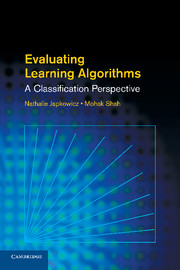Book contents
- Frontmatter
- Contents
- Preface
- Acronyms
- 1 Introduction
- 2 Machine Learning and Statistics Overview
- 3 Performance Measures I
- 4 Performance Measures II
- 5 Error Estimation
- 6 Statistical Significance Testing
- 7 Datasets and Experimental Framework
- 8 Recent Developments
- 9 Conclusion
- Appendix A Statistical Tables
- Appendix B Additional Information on the Data
- Appendix C Two Case Studies
- Bibliography
- Index
Appendix B - Additional Information on the Data
Published online by Cambridge University Press: 05 August 2011
- Frontmatter
- Contents
- Preface
- Acronyms
- 1 Introduction
- 2 Machine Learning and Statistics Overview
- 3 Performance Measures I
- 4 Performance Measures II
- 5 Error Estimation
- 6 Statistical Significance Testing
- 7 Datasets and Experimental Framework
- 8 Recent Developments
- 9 Conclusion
- Appendix A Statistical Tables
- Appendix B Additional Information on the Data
- Appendix C Two Case Studies
- Bibliography
- Index
Summary
Tables B.1 and B.2 show the results obtained using 10-fold cross validation by c45 and NB on each instance of the labor data respectively as output by WEKA. The first column lists the instance number; the second column lists the instance label, where class 1 corresponds to class “bad” and class 2 corresponds to class “good”; the third column lists the predicted class, using the same naming convention; column 4 uses the “+” symbol to indicate whether the predicted label differs from the actual one and a blank if they are in agreement; finally, the last two values, which are complementary and add up to 1, indicate the confidence of their prediction. The first value indicates how much the classifier believes the instance to be of class 1 (bad), and the second indicates how much the classifier believes the instance to be of classs 2 (good). The dominant value is preceded by a “*” symbol and corresponds to the value of the predicted label.
Please note that the numbers denoting the instances in the first column are not sequential. After number 6 or 7 is reached, a 1–6 or 1–7 sequence is repeated. This is because every 1–6 or 1–7 sequence represents a different fold. Indeed, it can be seen that 10 different sequences are present in each classifier run, corresponding to the 10 folds of 10-fold cross-validation.
- Type
- Chapter
- Information
- Evaluating Learning AlgorithmsA Classification Perspective, pp. 364 - 367Publisher: Cambridge University PressPrint publication year: 2011

